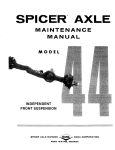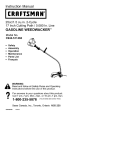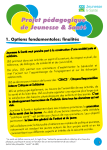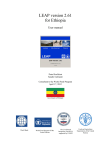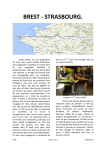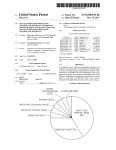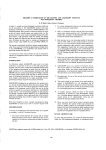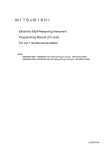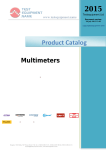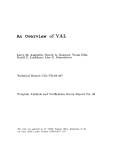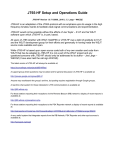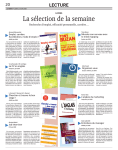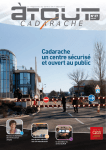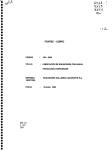Download Winter 1996 - Orange County Radio Amateurs
Transcript
NBI RBPBATBRS ON TIIB 41R OCRA's two new repeaters, 442 .15+ and 53.45-, are now on the air at their final location, a platfonnjust over 1000' up the new WUNC television broadcast tower just southwest of Chapel Hill. With the bottom of the tower itself at around 790' above sea level (some 400' above average terrain), the repeaters have great elevation and thus superb effective range. Both repeaters carry the OCRA callsign, currently KE4ZXZ, but will be changed to something more distinctive such as W4UNC , W40C, W4AW, etc. (more on "vanity" and club calls later in the newsletter). Three large weatherproof cabinets, fastened directly to the platform grating, house the radio equipment. Mounting brackets on the outside of the platform provide at tachment points for the two antennas, both mounted to provide optimum coverage toward Chapel Hill and Durham. Additional work is planned to improve the instal lation and ensure continued system reliability. The day after 442 .15 went on the air, one ham carried on a QSO from downtown Winston-Salem with an HT running three watts. Soon after, several hams were heard checking in from the Benson hamfest. Coverage extends throughout most of Greensboro - with an HT and rubber ducky inside a car! This wide coverage will be a tremendous advantage for ARES and other emergency operations in the area. The 6m repeater is being heard clearly well into Virginia and South Carolina, though interference apparently from one of the nearby commercial FM broadcast transmitters is jamming the receiver and making it difficult for distant stations to get into the repeater. The repeater crew is working on resolving the interference prob lem , and with luck the machine will soon hear as far as it can be heard. Frequency PL tone* Controller Transceiver Power Supply Preamp Duplexer Antenna Power to antenna ERP 442.15+ 53.45 131.8Hz 107.2Hz S-Com 7K S-Com 7K Motorola MSF Limited Motorola Micor Motorola Astron RM-50M Advanced Receiver Research GaAsFET preamps on both Celwave Wacom DB Products DB413 Celwave 2-pole Cardioid 8-pole in-phase 12dBd 6dBd gain 85W 45W 1,280W 180W * Transmitting a DTMF tone "5" for several seconds will temporarily disable the tone squelch, enabling hams whose rigs don't have PL tone capability to bring up the repeater. DPEB4TIDIf HDIrLlKE! Operation Snowflake is a volunteer pro gram for transporting medical person nel to and from UNC medical facilities in the event of winter weather produc ing poor road conditions. A radio net will be used to dispatch hams with four wheel-drive vehicles and mobile radios in the local area. All hams with appro priate vehicles and radios are welcome to participate. Contact John Welton, N4SJW, for details (966-6321 or e-mail jwelton.nur l @mail.unch.unc .edu) . Presstime update : Operation Snowflake was activated during a snowstorm the weekend of January 6, .and it went very well. Several ha ms spent many hours over the weekend oriving hospital workers from as far away as Johnston County to UNC Hospitals and back, while others pitched in by acting as net control station or by riding shotgun in 4x4's belonging to non-hams. UNC snow desk personnel expressed much appreciation for OCR A mumbers' assis tance in this operation. This sort of community service is what OCRA is all about. Be prepared, and be involved! CLUB DD LDCAL NBIS Search and Rescue Several OCRA hams on the Durham Search and Rescue team participated in a mock search exercise in late January. Joining them on the air were some new hams: Durham SAR team members who recently completed a Novice/Tech course taught by Dave Snyder, N2MLU. Their much-delayed call signs became available from a newly-funded FCC just in time for the exercise. The practice search was held at the Eno River state park at the end of Cole Mill Road in Durham.Tive teams searched for two "lost" hikers. There were not enough Park Service radios to go around, so each team was assigned a ham operator and messages were re layed to the command base via a team with both types of radios. A mobile crossband repeater was set up to boost signals out of the river valley up to the 442.150 machine and to allow the hams with 2m-only gear to communicate. The hikers were eventually located and the mission was pronounced a success. Anyone interested in getting involved with Search and Rescue should contact Dave Snyder, N2MLU about training and participation. aDU IRES Ret Bas laved The Saturday morning OCRA ARES practice net has moved from the DFMA's 147.225 Hillsborough repeater to OCRA's new 442.150 repeater. The net time and format remain the same, Check in whenever you can, and sign up to call the net sometime to gain experience in running an ARES net. You never know when your service may be needed. All at OCRA express our sincere thanks to DFMA for allowing us the use of 147.225 for our nets in the past. License and Training lews . Dave Snyder, N2MLU February Testing Session The next ARRL accredited VE session from OCRA will be held on Saturday, February 10 at 10:00anl at the Hillsborough 911 Center. VE's are needed to help run the session, in particular those interested in learning how to properly handle all the paperwork since Dave Snyder, N2MLU, our current liaison, may not be available at all the sessions this year. Any persons going for a new license or an upgrade may contact Dave at (919) 644-8681 or e-mail at ..djsnyder(@interpath.com.. to pre-register. NovicelTech Class Starting in April The OCRA Novice-Tech License Class will be held Fridays, from 7:00pm to 9:00pm at the Hillsborough 911 Center, 1914 New Hope Church Road. It will run from April 12 through June 7. Classes will include both code practice and theory lectures and demonstrations, and quizzes based on the question pools. A registration fee of $30.00 includes the textbook "Now You're Talking," all class materials, and one year's membership in the Orange County Radio Amateurs. The course will emphasize knowledge of materials to pass the Novice and Technician License exams. An ARRL accredited Volunteer Exam Session will be held on Saturday, June 8 at 10:00am; exam fees are $6.05. For further information and to pre-register, Contact Dave Snyder. Notice to OCRA members - contact me to help out with the course. TVe need to spread out the work; I can't do it alone] Vanity Call Sign Update "Vanity" call signs will soon be available from the FCC; you can apply for one by using Form 610V. Applications will be processed in groups called "gates." No dates for the gates have yet been set; gate one will probably not open until after the first quarter of this year. Here's how the gates are defined: Gate 1 - Licensees may request previously held call signs. Club station trustees may request previously held club calls. Gate lA - Club station trustees may request in memoriam call signs of deceased club members. A club station license must have been held on March 24, 1995. A letter is required from a relative of the deceased member confirming association with the club and giving assent to the club's use of the call sign. Gate 2 - Exira Class Ops may request group A,B,C, or D call signs for their own stations. Extra Class trustees of club stations may request A,B,C, or D call signs for club stations, including in memoriam requests. Gate 3 - Advanced Class Ops may request group B,C, or D call signs for own use, or if they are Club station trustees, request same for club calls, in memoriam requests inclusive. Gate 4 - General, Tech Plus, or Technician class licensees may request group C or group D call signs for themselves or as club station trustees. Novice Class licensees may request Group D only. Other restrictions - Vanity calls can use the number of any call district, regardless of where you live. However, if you reside within the contiguous 48 states, you cannot ask for a call prefix allocated outside these bounds. For instance, a KH6 call will only be issued to Hawaiian residents, and KP4 calls will only go to residents of Puerto Rico, With the exception of Gate 1 and 1A qualifications, a call sign must have been vacated for two years before it becomes available to the pool. This is to discourage the "warehousing" and selling of desirable calls. Page 2 FLOB Communications Site Update John Weltoll, N4SJW The club has made progress on developing the UNC campus repeater site (Faculty Laboratory Office Building, or "FLOB"). We installed a second antenna and ran new Belden 9913 feedline to the equipment cabinets. In addition, we installed grounding straps and placed Polyphaser lightning protection units at the building entry point. This nearly completes the outside work at FLOB and we can now tum our attention to the "inside job". We plan to get a second cabinet up for the digital equipment in the next few months. This will give us a direct link to the DX PacketCluster node in Raleigh on our coordinated frequency, 144.99MHz. This is a standard simplex 1200 Baud packet node. Equipment has been ordered and integration will commence towards the end of January with a February - early March start-up date. We are discussing further enhancements to the site. A phone patch is being investigated and I am exploring the possibility that UNC or UNCH will donate the phone line to us. We also are considering putting a 2M remote base at the site. Another thought was to install a digital voice recorder so club announcements could be tied into the site and club members could leave messages for one another. Please give us your feedback on these ideas. We also welcome other suggestions for developing the site. I would like to thank KD4CPM, KR4UB, and KZIX for their help on a truly miserable New Year's Day working on the roof of the FLOB building. I also look forward to 1996 with many exciting possibilities for the club and further enhancements to our communications capabilities. Anyone who is interested in participating in working at the UNC campus site is welcome. This is a wonderful opportunity to gain experience in working with the hardware, and there is plenty of room at the repeater site to work with. Please give me a call on the air or at home (966-6321) or e-mail [email protected] if you would like further information. Editor's note: The KZIX 443.475+ repeater was removed from the old tower location early in 1995 and moved to the roof of the FLOB, one of the highest spots on UNC's campus. This repeater gives good local coverage in the Chapel Hill area, and its location near UNC Hospitals should make it a highly valuable resource in the event of a large-scale emergency. It has the same PL access tone as the 442.15 repeater, 131.8Hz. let In IISIT B-Mail Iddress Paging Systems far Dell Repeaters Does your electronic mail address wrap on an 80 column screen? Are you tired of people saying "wait, lemme write that down, it's too long to remember?" Do you wish people would get it right the first time (or even the fourth time)? Help is here. The Amateur Satellite organization, AMSAT, will provide you with an e-mail address of "[email protected]" and forward mail from there to your "real" address. Now when a ham asks you for your e-mail address, you can just say "send it to me at AMSAT," and chances are he'll know what you mean. If someone knows your callsign, he's got your e-mail address. Steve Jackson, KZIX, is pursuing two routes to providing OCRA members the capability of being paged to monitor our repeaters in the event of an emergency. The basic aim of both schemes is to allow OCRA members to be able to quickly alert other members to important communications via our repeaters, without everyone having to hear the daily chatter of the other repeater users. One scheme "ill use the eventual 2m voice capability planned for the FLOB site; inexpensive weather radios (e.g., from Radio Shack) with tone alert activation will be modified to receive our 2m repeater frequency. When a "call-out" is needed, the caller will have the repeater transmit the alert tone, and the receivers will activate. Just send a message to [email protected] containing your call sign, e-mail address, and a polite request, and they'll set up the forwarding service for you and notify you when it's done. And - get this - it's completely free! Of course, it is costing AMSAT some money, so it would be a good idea to join AMSAT and help them support this project as well as the Amateur satellite program. It would make keeping up the club roster much easier if all OCRA members with e-mail addresses would take advantage of this opportunity to standardize. The other scheme involves modifying inexpensive commercial voice pagers to receive on 442. 15MHz. These pagers use a standard 2-tone paging code to open the squelch, so each OCRA member would be assigned a unique code. A caller could page an individual club member by transmitting that person's code, or the repeater controller's macro capabilities could be used to page any defined group of people (including all users). The pagers Steve is testing this system with are inexpensive ($15 for the pager, $10 for the charging stand; $25 for the conversion to 442.15) and small, which means members won't have to always have a bulky 440 transceiver with them in order to be called on the club repeater. Steve will let us know as things progress. Page 3 New tear's lreeting from OCBA's President Happy New year! As ,ve look with optimism toward 1996, allow me to take a quick glance back. 1995 was a banner year for the Orange County Radio Amateurs] Among the many things that our club accomplished, the following events were particularly significant: • Agreement by UNC Hospitals to support our new 440MHz repeater. This provided crucial support to our effort. • Development and approval by the club of a comprehensive strategic plan for communication equipment acquisition and deployment. This plan includes the new 440MHz repeater, 50MHz repeater, development of the WUNC tower location as well as a new location at the Faculty Laboratory Office Building (FLOB) at UNC, and future plans for 2m voice and data capabilities. • Development of a comprehensive fundraising effort incl uding a full briefing book for potential donors to our communication plan. • Financial support by the Town of Chapel Hill, Orange County, the Village Companies, the Durham FM Association (DFMA), and individual club members, combining with the UNC support to total in excess of $28,000. • Administration of at least four Amateur Radio Volunteer Examiner testing sessions. • Completion of both a Novice/Technician and a General Class educational program. • Renewal by the ARRL of the highly-regarded "Special Service Club" designation. • Recognition of our Field Day efforts resulting in first place awards for our class 5A entry in both the ARRL and the QRP competitions. • Assistance in ham station installation at Phillips Middle SchooL • Active participation in at least three community events requiring Amateur Radio support. • Development and operation of the new UNC location at the FLOB for the 443.475MHz repeater and the building of capacity for additional equipment development. • Development, fabrication, and installation of the 70cm and 6m repeaters on the WUNC tower, now in operation at the 1000' platform, As you can see, our club has been very busy and I believe should be very proud of its accomplishments. These very significant milestones were the result of the efforts of many club members who worked very hard on behalf of our community and in support of Amateur Radio. 1995 also saw the relocation of our former President and head cheerleader, John Hughes, NORXK, as he and his family moved to Utah. As you are aware, John's efforts in the club, particularly in fundraising, were instrumental in our success during the year. When I assumed the Presidency in 1995, John agreed to continue responsibility for the completion of our fundraising endeavors. With your help John was more than successful. I continue to miss my good friend John, and I know that you'll join me in thanking him once again for his contribution. As we move forward into the new year, let us also acknowledge the very important contributions made by our sister club, the DFMA, in our development. DFMA has been very gracious in allowing us the use of the 147.225MHz repeater for our nets, provided the first donation toward our 440MHz repeater, and has continually been helpful in our growth as a club. As we move our net to the 442.15MHz repeater, let's not forget how much help DFMA has been to us. Our Board of Directors has worked hard on everyone's behalf this past year, and I would like to personally extend my most sincere appreciation for their efforts. I would like to especially thank Vice President John Welton, N4SJW, for his assistance in almost every aspect of our club this year. Thanks most of all to each of our club members who has made this club successful. Your work on behalf of our hobby and in support of our community has been incredible. I know many of you have worked many, many hours - THANKS for making 1995 a banner year! 73 de Paul Halverson, KR4EA No DI for atear?! John LloJJd,KE4 [lTX I entered Ham Radio in January 1995. I had been an avid DXer of shortwave broadcast stations for 20 years and decided that I would like to branch out into two-way DX communications. I studied hard and joined the hobby with an Advanced Class ticket With the help of W4YOS, Joe and K8IJD, Bill, I got my station on the air, For the first four months I had a ball. I worked DX on 40m through 10m with 100 watts and a system of dipoles. I made friends in Australia and Italy. I kept regular contact with on old friend in Belize. By the end of those first four months, I had worked about 50 countries and 40 states. Then, disaster struck. I would have to move from a duplex in the country to an apartment in the city with no antenna space. Since I signed a year lease, it seemed like that would be the end of my DXing for at least a year. Could I live without DX? No! The solution was mobile DXing. I installed a $20 mobile antenna on my pickup truck and connected the radio in about an hour. I began calling CQ and got an immediate response, "Please QSY - you're causing QRM." I was embarrassed, because I should have checked to see if the frequency was clear first, but also happy because I was getting out! (Continued on page 5) Page 4 (Continued from page 4) For the first few weeks, I worked DX from the pickup outside the apartment. I worked my first lA, 9K2, RO and many others. Then, another problem struck - the other residents of the apartment had me 5-by-9 on their telephones, TVs, and stereos! Needless to say, the landlady was not as enthused as I was over my DXing. My wife, who was studying for her ticket at the time, told the landlady it was her problem for not having installed proper wiring. I did not want to be a bad neighbor, so I searched for another solution. I began looking for suitable DXing locations near my apartment. I found several: office parking lots, state parks, wildlife observation areas, and rest areas. I quickly realized that it was possible to work DX from just about anywhere. I not saying it's easy, but I'm still working new countries and having fun! 73 and Good D.LY de John, KE4[JT.¥ CI Traffic Ilts What are they, how do I get started, and for that matter, why should I? Ed Lappi, AE4EC Are you tired of listening to the same old code tapes in an effort to get your code speed up? Are you nodding off at the keyboard while practicing with SuperMorse? If so, there are two or three other ways to improve your code copying skills. First, you can listen to ARRL's WIAW code practice sessions. WIAW sends picture-perfect code which is easy to copy, but with the added challenge of copying through QRM and/or QRN the same as any CW contact. Second, you might simply get on the air and get involved in CW QSOs as often as possible, again having to listen through the noise. And third, you can start checking into CW traffic nets, starting with the slow speed nets such as the Carolinas Slow Net (CSN) on 3715KHz each evening at 6PM. If you can't copy CSN there are many other CW nets throughout the country for you to listen to and participate in. Just what is a "traffic net?" It's part of the National Traffic System (NTS), the network of amateur stations that passes messages throughout the country via various radio operating modes. Amateur operators meet on the air at a scheduled time for a "net" to pass traffic from one place to another. "So," you ask, "how do I check into a CW traffic net? I don't want to embarrass myself or make those other net stations think that I am a 'Lid'." Not to worry - most slow speed CW traffic nets are specifically training nets where first timers (and sometimes old timers) are expected to make mistakes. Most slow speed net controllers will be patient and courteous, and will help you as much as Wireless Headphones from Radio Shack Steve Jackson, KZIX, reports that Radio Shack is selling monaural wireless infrared headphones, part number 33-1141, for $39.95. Besides the uses you've likely seen advertised for these gadgets (watching TV without bothering your spouse), these would give you a great deal of freedom to move around your radio room. No more being shackled in the shack! Here's hoping Radio Shack takes the next logical step and decides to manufacture a wireless infrared boom-microphone headset! possible to make you feel welcome. Most nets have some sort of preamble to announce the activation of the net and to give check-ins time to zero-beat the Net Control Station (NCS) frequency. Be aware that nets don't always meet precisely on the advertised net frequency. Nets don't have a special right to any frequency, and most NCSs will shift the net frequency to avoid QRMing a QSO already in progress. So, sometimes you have to hunt up or down a few KHz to find the NCS. Usually NTS nets have liaison stations from other section nets check in to carry traffic to and from the other nets, so after finishing the preamble the NCS will next ask for liaisons to check in. For example, on the CSN, NCS will send QNA NCEN REP QNIK whereupon the liaison station to the North Carolina Evening (SSB) Net will check in. Then NCS will follow with: QNA CN REP QNIK asking for the Carolinas (CW high speed) Net liaison, and QNA SCSSB REP QNIK asking for the South Carolina SSB net liaison. Then NCS "ill send CSN DE AE4EC QNI K whereupon a checking station usually sends one letter of his/her suffix or the last three letters of his/her call and NCS responds with those same letters. The station checking in then sends: DE W4EAT QTC AE4EC 1 AR meaning that W4EAT has one piece of routine traffic for the NCS. Or, W4EAT might send DE W4EAT QRU AR meaning that W4EAT has no traffic for this session of the net. (Continued on page 6) Page 5 (Continued from page 5) Net Control for the CSN usually takes check-ins for at least the first ten minutes or until check-ins have slowed down significantly. At this time if there has been traffic listed, NCS will usually have stations pass at least one piece of traffic on the net frequency so check-ins can listen. If there are more pieces of traffic, NCS will usually send the transmitting and receiving stations off frequency to pass the traffic. NCS will then begin releasing stations from the net. To release a station, NCS will send the suffix of the station call for the station he is releasing; for exarnple, JRE for N4JRE. N4JRE now responds with the letter R or some other response of his choice. NCS will now send TUNW QRU QNX 73 K meaning "Thank you, there is no traffic for you, you are excused from the net, and 73." The station being released will usually respond with TU 73 DE N4JRE SK whereupon the NCS will release the next station and so on until all stations have been released and there are no more check-ins, at which time NCS will close the net. The CSN usually runs anywhere from ten minutes to as long as half an hour if there are sufficient check-ins and traffic listed. The reason traffic nets improve your code copying skills is that when taking traffic for delivery or relay you are forced to concentrate 100% for a short time. On "ordinary" CW QSO's you do not need 100% copy to get the gist of the conversation, but you do not want to make any mistakes at all in copying traffic that you're going to have to pass on to another person. After becoming proficient on a slow speed net, there are plenty of medium to high speed CW traffic nets you can graduate to for continued improvement. Keep in mind that even the best traffic handlers started someplace making mistakes at first, so don't be afraid of making those same mistakes - come join us on a CW traffic net and learn. As W4EAT, frequent NCS on local traffic nets, continues to tell us traffic handlers, even he learns something every day on traffic nets. Sending Traffic Via a CI Traffic Net Ed Lappi, AE4EC Say AE4EC has a piece of traffic for the net. After NCS recognizes his one letter attention getter (E), he checks in as follows: DE AE4EC QTC THRU 1 AR meaning that AE4EC is listing one piece of through traffic (traffic destined for out of state). Say W4EAT is the Carolinas Net (CN) liaison; NCS will send his last three letters, and W4EAT will respond in his chosen way. Then NCS will send EC and AE4EC responds usually with a T. NCS will either have W4EAT pick up the traffic on the net frequency by sending QNKTHRU 1 HR or he will send the two stations off frequency by sending QNY DN {or ITP} 5 QNK THRU 1 K. NCS may also excuse both stations after traffic has been passed, meaning that they do not have to return to net frequency afterwards. The receiving station will always call the sending station and is always in control, so the sending station should listen to his instructions carefully. AE4EC DE W4EAT GE QRV K "Good evening, and I'm ready to receive traffic." W4EAT DE AE4EC R TU PSE CPY "Roger, thank you, please copy" NR 1 R HXG AE4EC ARL4 CARRBORO NC OCT31 JOHN SMITH AA 111 DOWN ST AA HOPALONG, FL 31111 AA 809 555 6155 BT ARL FORTY SIX X 73 BT EDARN "After my signature, end of message, no more." AE4EC sends AA after each address line to tell W4EAT that a new address line follows and BT to indicate end of address section. After text has been sent AE4EC sends another BT to indicate end of text and that signature follows. After signature is sent, AE4EC sends either AR N to let W4EAT know that he has no more messages, or he sends AR B to indicate that he has more to follow, and finally he sends AR N after the last message is sent. Page 6 TBE LoC4L INFoRM4TIDN '4DE IllS leetings ud Nets The Raleigh Amateur Radio Society holds its meetings on the first Monday of each month at Forest Hills Baptist Church on the comer of Dixie Trail and Clark Avenue in Raleigh. Donuts, drinks, and socializing begin around 7pm~ the meeting itself starts at 7:30. RARS has a nightly net at 8:00pm on 146.64 MHz. The Orange Caunt, Radio Imateurs leetings DCII Officers OCRA holds its regular meetings on the second Monday of each month, 7:30pm, at the Orange County Emergency Operations Center on New Hope Church Road just east of its intersection with NC highway 86, north of Chapel Hill. President: Paul Halverson, KR4EA 932-5558 Vice Pres.: John Welton, N4SJW 929-7976 Secretary: John Crouch, AB4VU 929-1788 Treasurer: Barbara Pederson, KE4JZM 929-3301 DFlI leetings aad Nets The Durham FM Association holds it meetings on the second Tuesday of each month at Picadilly Cafeteria in South Square Mall in Durham. Dinner starts at 6:00pm~ the meeting proper starts at 7:00. Talk-in on 147.225. The DFMA 2n1 net is called at 7:30pm each Wednesday on the 147.225 Hills borough repeater. Badio Nets The OCRA ARES practice net is called each Saturday morning at 9:30am on the 442.150 Chapel Hill repeater. The OCRA 10m net is called each Monday evening, except the 2nd Monday of the month, at 8:00pm on 28.360MHz USB. lembership Information Annual Dues: $12.00 Mail to: Orange County Radio Amateurs 1914 New Hope Church Road Chapel Hill, NC 27514 The DCII Newsletter Local lam Gatherings Thursdays at lunchtime, hams in and around RTP gather at one of a number of favorite restaurants for lunch. Folks start arriving around 11:3 Oam; some straggle in as late as 11:45. Anyone is welcome to join the crowd - just listen in on the 146.64 Raleigh repeater starting at 11:20 for talk-in. E-mail Ken Ed wards at [email protected] for location announcements. Saturday mornings starting at 8:30am there is a gathering of local hams in Hillsborough at Oliver's restaurant, 3/10 mile north of the 1-85 intersection with Old 86 (Churton St.). Look for the green sign - the restaurant's set back from the street. Bring your HT and check into the OCRA ARES pratice net over eggs and grits. Local info on the Interl1lt A summary of Triangle-area ham activity (clubs, repeaters, packet, etc.) appears sporadically on the Usenet newsgroup "triangle. radio." This is a great resource for newcomers in the area. There is also a World Wide Web page put together by the NCSU radio club in Raleigh. Besides NC State radio club information, it also has many links to other good Amateur Radio pages across the nation. Check it out at this URL: http://www.acs.ncsu.eduIHamRadio/ StARS! This newsletter is published sporadically, though with a recent surge in contributions by members it appears that we will be able to produce an issue quarterly. Any topics of interest to the ham community in general or the Orange County ham community in particular are welcome. Please share your experience with other area hams through this medium, whether your interests lie in equipment, operating, policy, homebrewing, contests, whatever. If you have an article or news item you'd like to see in the next issue, please contact Joe Simpson, KD4LLV, at (919) 541-5941 or 477-1481, or send an e-mail message to [email protected]. Page 7 In Bu,-to-Build, Low-Cost Intenna for 148/44D Mlz Ed Lappi, AE4EC I claim no originality for this antenna, as it was first described in a 1989 73 Amateur Radio article by W3RW and W3LOY. How it Works The antenna works in different modes on each of the bands. On 146 MHz, the performance is virtually identical to that of a quarter-wave whip. At these frequencies, depending on the ground plane configuration, the performance can be sigiiificantly supenor to. the rubber duckie antenna, and can even come to WIt~ a small fraction of a dB of a conventional 9-t¥Wer-wave located in the same ground plane environment. The ~~ characteristics and bandwidfh also behave similarly to a quarter-wave monopole. The real virtues of this antenna appear in the 440 MHz application. Many have been surprised to [rna that they were ableJ~Eet some measure ofrerformance when they operated on 449 MHz with a conventiona 146 MHz whip. In fact, a 146 MHz whip functions as a 3/4-wave \vhip when used at 440 Mllz, and presents a very acceptable SWR to the rig, But then, any piece of wire Will radiate to some degree, in some direction. And there's the rub : some direction. Most of the radiation from a 3/4-wa,:e vertical whipover a ground plane is directed up into the sky! It WIll send a mce SIgnal at about 48 degrees above the horizon. That's not where we want our signal to go most of the time! This easy-to-build antenna; while occupying essentially the same space as the 146 MHz vertical whip, behaves quite differently on 440 MHz than the 3/4-wave sky warmer. The secret IS In the altered current distribution resulting from the addition of the "curly-Q'' inductor inserted into the lower part of the whip. Because of the resulting current distribution, the antenna behaves similarly to the classical 5/8-wave vertical, which not only provides several dB of gain over a quarter-wave whip, but also directs ItS radiation toward the honzon, where we want It to go, The curly-O inductor not only ,establishes the, ideal current distribution, out also performs the Impedance matching required to make a highly reactive, high Impedance 5/8-wave whip 100k h~e the 35- to 60-ohril resistive load we want to match to our )O-ohm ngs! Construction 2-tum coil, 1/2" diamater spread over 5/8" distance ~ 15"-long whip L 2/3'" base The antenna is simple to build, Actual dimensions vary slightly, depending on the application, but In aI}-Y case appear to be non critical, Fonning the base .loading _coil IS the hardest part of construction. When constructmg the lIT antenna, I worked With 1~ gauge coppef\veld wire. I found it relatively easy to form the COlI around a 112" drill bit shank. The easiest \vay to start construction of the HI antenna is to measure the length of wire for the location of the loadmg cod, form the loading coil and mount the antenna onto the BNC connector. Then, measure for the vertical whip and cut. I salvaged a BNC connector from a spare rubber duckie antenna I had. In my case, once I had the connector free of the rubber duckie, I had to drill a hole into the center of the BNC top to take the wire. I then soldered the Wire element to the BNC connector and worked heat shrink down over the top of the BNC to provide weather protection: I also placed sonle heat shrink at the very top of whip to prevent mjury to both myself and other people when in crowded places. Once completed, the next step is to trim the antenna for optimal 2 meter band operation. It does noJ~~ar to need adjustment for 440 MHz operation, since observed SWRs have not been higher than 2:1. Performance According to the original authors, the antenna's performance appears to equal that of a quarter-wave whip on two meters and seems to provide between 3 to 5 dB gain on 440 MHz. Though I did not perform precise measurements, I do know that I cannot get Into the 2l42. 15 repeater from my office and cannot copy any 2-meter repeaters at all with a rubber duckie - but With this home-brew antenna I can cQl?Y 2-uleter repeaters and can &et into the 412.,15 repeater from my office, in the center of a steel ana concrete building, If you would like to experience some gain from your fIT without the use of a 5/8-wave whip, give this little jewel a try. 73, and good luck! - Ed, AE4EC The 14DI DI PacketCluster(tm) AfikeA1cLendon,KE4END The W4DW DX PacketCluster is a part of a packet radio based network system. Ibis system permitsharris to pass DX and contest station information to each other by USIP.g personal computers or data terminals connected to radio transceivers through devices called Terminal Node Controllers (TNCs). PacketCluster Software . PacketCluster is a copyrighted software program written by AKIA and Pavilion Software tliat IS onented to the DXer or contester PacketCluster allows individual users with PCs to connect their packet stations to the W4DW node and allows PacketCluster nodes, like W4DW, to connect together to form a cluster. I heard a good one! . . . . When rare DX, a good pile-up, or a new multiplier IS spotted by a ham he or she posts a spot to the local PacketCluster node. A spot might look like this: DX ZAIA 14010 very loud now This spot says that ZA1A was heard on 14.010 MHz and is very loud now. The spot is broadcast to everyone connected to the local PacketCluster node. But it doesn't stop there - the spot IS also broadcast to all of the other nodes in the cluster and on to all of the users logged into each of those nodes. So, a single DX spot may' be sent to hundreds of stations! Conversely, any SIngle station connected to the PacketCluster will receive any DX spots posted by other stations connected throughout the cluster - sometimes as many as 300 or more! What else can it do? . . The W4DW PacketCluster plays an important role jn emergencies and drills when it is turned over to ARES operation for passing traffic. During normal operation, the PacketCluster computer provides users access to a number of on-hne databases. including information on QSL managers bureau addresses, ham-onented 800 numbers contest dates amateur equipment dealers, and the FCC database'of all licensed US amateurs. Can I use it? How do [find it? . . The W4DW PacketCluster isopen to any person who IS senouslY interested in DX or contesting, though no contest club or DX affiliation of any kind is required, The Packett.luster I~ not .designed with casual packeteers tinkerers, or CurIOSIty seekers m mind, -It IS intended for use by those hams who are Involved In the DXing as~cts of the hobby. Nodes are on 147.57,145.09 (connect W4DW or RDUPC) and 144.93MHz (connect SWAN and then type DXC after you connect) at 1200 baud. There is also 1200 baud access from points southeast of RaleIgh thro:ugh DXJARS on 145.67 MHz (connect DXJARS and then C W4DW). There are other access nodes north, east, and west of Raleigh that are in. [mal planning stages - so eventually almost anyone within 50 miles of W4DW will have access to a'node. As these nodes get on the ai~ their frequencies will be announced through the Raleigh. Amateur K~dIO Society (RARS) newsletter, The Exciter., They will also be hsted in the monthly Triangle amateur activity posting that appears on the Usenet newsgroup triangle. radio. (Continued on page 9) Page 8 . er er ona Ions nor e the PacketCluster operation. (Continued from page 8) How do I get started? One of the easiest W'!j'S to get started using the PacketCluster is with the help of a ham friend who already uses it. There is also an excellent user's manual which is available from the PacketCluster SIG treasurer for $10 (picked up) or $15 (sent by mail). The manual includes a comprehensive command reference, frequency, baud, and node information, TNC configuration and other very important information you WIll need to enjoy all of the PacketCluster features. See below for the ordering address. What • • If you have already been using packet radio and want to log into the cluster, you may not have to make changes to your packet confiEuration - check the manual section on INC setup to find out. The Dig difference between the PacketCluster and what you may be used to is that you connect to the cluster and stay connected for all functions. You will be able to communicate with other stations logged into the cluster without having to connect to them directly. • Please - NO BEACONS! NO CW IDS! If you want to experiment or connect. to another station, please move to a frequency that is not a cluster Input. • What equipment do I need? • Any average amateuryacket station will do. You need a Terminal Node Controller (TN~), a 2-meter transceiver (handy-talkies are not well-suited), and a simple Ascn monitor and keyboard. The latter requirement may be met by a computer running most any kind of terminal software package such as is used to interface the computer to a telephone modern. SImple programs (e.g., ProComm Plus) are available for all popular types of personal computers. Manyusers have only a simple, "dumb" ASCII terminal connected to the TNC - and this suffices quite nicely. Some advanced users have custom terminal programs that interpret data coming from the cluster, sounding audio alerts, tuning rigs to the frequency and mode listed in the spot, preloading a logging program with pertinent in format ion, rotatmg directional antennas when needed DX ISposted, etc .. Ideally, the terminal or computer's display should have at least 80 columns, since the informatiori presented is formatted that way. Many TNCs are available and all operate basically the same way; but, as WIthany equipment, some are better than others. The most Ropular units are built by ABA, Kantronics, and MF 1. All are compatible with each other. It is important that you put a strong, clean signal into the PacketCluster and have your deviation adjusted properly. It is also fairly important that vou are heard by as many users around you as is practical; when operating optimally, each packet station does its best to avoid collisions with other packets - and that means it's necessary that both the network node ana other DXers on the system hear you. A good omnidirectional antenna at the highest elevation possible is ideal, and you should run as much power as you are able (wi thin reason) so that other packet stations will hear you and not "walk all over you". U1JIo Operates tile PacketCluster? The RARS PacketCluster is operated by the Swan Island DX Association, an association of its users. There is a monthly informal users meeting at O'Malley's on u.S. 70, west of Crabtree Valley. The meetings usually run from about 5:30 to 7:30 PM. There is food, technical discussion, and occasionally some bragging. Everyone who is interested in DXing or contesting IS cordially Invited to attend. The PacketCluster system operator (SYSOP) is Rick, KA3PSK. A Technical / PlanningCommittee is heade4!2Y Paul, NOOT and Mike, NT40. The Treasurer is Mike, KE4ENlJ. Bob, KB9MS, also performs RF and electronic maintenance when he is available. Many people too numerous to list here donate their time and money. It has been customary that if you use the cluster, you should consider a donation to assist with its operation. The technical and planning committee meetings are always open to anyone who wants to. contnbute time and energy helping to plan and run the cluster operation. How is tile PacketCluster funded? The PacketCluster has been financed over the years by a balance of voluntary user donations (which are welcome at any time) and a RARS budget allocation. Most users making donations do so to show their support for maintaining and improving the PacketCluster. The PacketCluster network is not cheap to install and maintain. Computers, radios, antennas, miscellaneous equipment and software • • • • • • • iS~_1l~nedfor thefuture? A UHF user access at 9600 baud is planned very soon; when it becomes operational, details will be.available when you log onto the cluster on VHF and WIll appear In the RARS Exciter. Many improvements have been made and more are planned for the backbone. That's the highway that brings DX spots and DX related maillbulletins from both the northeastern U.S. and the southeast (excluding Florida). We have been steadily improving the pathways from r200 baud to 9600 baud. This helps to ensure that the .spots and other information can get here in a reasonable time, mmmuzmg network congestion. New cluster access nodes are being placed on-line even as you read this to prorerlY accommodate additional user growth. During a "contest weekend there are tunes that 8 to 10 new DX spots are seen each minute. With 25 users attached to the cluster, almost 250 DX spots may need to be sent out and acknowledged each minute. That's a lot of packet information that must be relayed - and that's why there are many different frequencies for the W4DW cluster. New Cluster software from VE3CDX, richer in features, is planned to replace the unsupported cluster software we now use. The PacketCluster computer will be upgraded to a 486 to improve performance and to handle more applications and features. The Hamcall database that gives hams' addresses, coordinates, etc. will be updated, and WIll include data for over 100 other countnes. We will provide other SYSOPs remote access to the cluster via phone lines to allow them to assist KA3PSK with system maintenance. Additional wiring improvements at KA3PSK are planned to provide for ~S power during CP&L power failures (storms or other natural disasters), Addition of a second PacketCluster node located at the State Emergency Qperation Center (EOC) offices in Raleigh will supplement the W4DW PacketCluster and provide redundancy for national and state emergencies. This may require purchases of additional hardware, radios, antennas and cluster software if necessary. This second PacketCluster node will be maintained and operated bv same group supporting the W4DW PacketCluster. Trained volunteers will be needed to support this node at the State EOC in time of disasters or drills. Additional access to the W4DW PacketCluster has been requested through the National Weather Service to pass weather related emergency traffic when needed. It has been proposed based on discussion at the PacketCluster SIG Planning committee meeting that an annual nominal user fee of $10 be imposed beginning m January 1996 to replace the donation part of the PacketCluster funding (this requirement may be waived in the case of hardship). The annual fee will serve to more fairly distribute the financial responsibility for the PacketCluster operation among its users. There are many users who contribute more than the $10 suggestion and who also put in many hours of their personal time to ensure that the PacKetCluster continues to serve the ham community in Raleigh. We hope to hold a social event such as a pig-picking or DX dinner, funded partially from the user !e~h in 1996. This is similar to operation of other SIGs within KAKS (e.g., VHFIUHF SIG). We will be looking for folks who have some expertise in ham cooking as well as ham radio ~ Contacts tor more informatioll: PacketCluster SYSOP Rick Merkle, KA3PSK (home phone 870-8268) 6412 Sassafras Ln Raleigh NC 27614 [email protected] Technical/Planning Committee Paul Sobon, NOOT Fujitsu Network Switching (790-2596) Raleigh, NC 27609 [email protected] PacketCluster SIG Treasurer (Manuals $10 picked U2 or $15 mailed) Mike McLendon, KE4END (home phone 528-1108) 9828 Whitt Rd Creedmoor NC 27522 [email protected] Page 9 Change of address or phone number? New callsign? Upgrade your license? Contact Joe Simpson, KD4LLV, at (919) 541-5941, 477-1481, or kd411v@amsaLorg so the club roster can be updated. Check your mailing label - if the year after your callsign is not '96, then our records do not show you as a paid up 1996 member of OCRA. If you've paid but don't see '96, contact the club Treasurer. If you haven't rejoined the club this year, why not do it today? Orange County Radio Amateurs 1914 New Hope Church Road Chapel Hill, NC 27514 / ,~(V:lf ct;,'I.- ',t-"'~''''jI' /1 / ;::.' iosille.... '-"'-(_, . r /"j /":::' " ....... .. R'// -r.-/":t;-'!-.c c .J /' ~ . , , , '" / <7; _ , (....'!-,d.J~'-v·,!.c·c_ ... )











